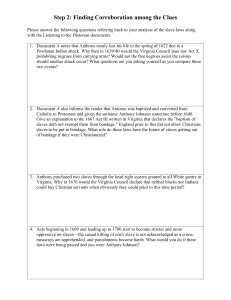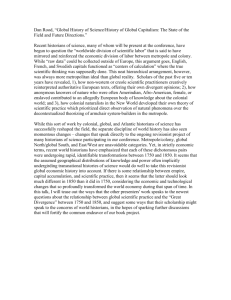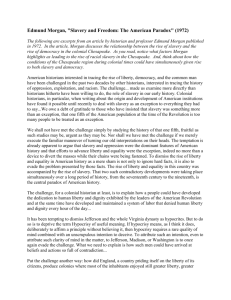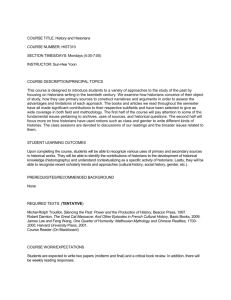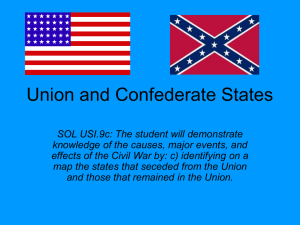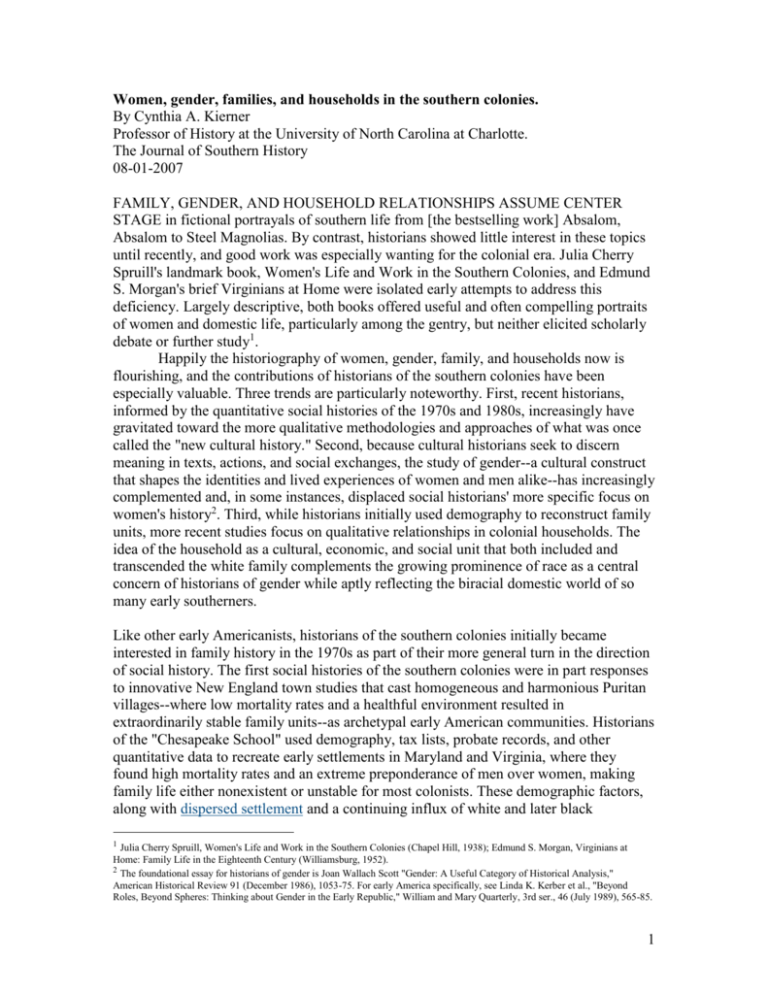
Women, gender, families, and households in the southern colonies.
By Cynthia A. Kierner
Professor of History at the University of North Carolina at Charlotte.
The Journal of Southern History
08-01-2007
FAMILY, GENDER, AND HOUSEHOLD RELATIONSHIPS ASSUME CENTER
STAGE in fictional portrayals of southern life from [the bestselling work] Absalom,
Absalom to Steel Magnolias. By contrast, historians showed little interest in these topics
until recently, and good work was especially wanting for the colonial era. Julia Cherry
Spruill's landmark book, Women's Life and Work in the Southern Colonies, and Edmund
S. Morgan's brief Virginians at Home were isolated early attempts to address this
deficiency. Largely descriptive, both books offered useful and often compelling portraits
of women and domestic life, particularly among the gentry, but neither elicited scholarly
debate or further study1.
Happily the historiography of women, gender, family, and households now is
flourishing, and the contributions of historians of the southern colonies have been
especially valuable. Three trends are particularly noteworthy. First, recent historians,
informed by the quantitative social histories of the 1970s and 1980s, increasingly have
gravitated toward the more qualitative methodologies and approaches of what was once
called the "new cultural history." Second, because cultural historians seek to discern
meaning in texts, actions, and social exchanges, the study of gender--a cultural construct
that shapes the identities and lived experiences of women and men alike--has increasingly
complemented and, in some instances, displaced social historians' more specific focus on
women's history2. Third, while historians initially used demography to reconstruct family
units, more recent studies focus on qualitative relationships in colonial households. The
idea of the household as a cultural, economic, and social unit that both included and
transcended the white family complements the growing prominence of race as a central
concern of historians of gender while aptly reflecting the biracial domestic world of so
many early southerners.
Like other early Americanists, historians of the southern colonies initially became
interested in family history in the 1970s as part of their more general turn in the direction
of social history. The first social histories of the southern colonies were in part responses
to innovative New England town studies that cast homogeneous and harmonious Puritan
villages--where low mortality rates and a healthful environment resulted in
extraordinarily stable family units--as archetypal early American communities. Historians
of the "Chesapeake School" used demography, tax lists, probate records, and other
quantitative data to recreate early settlements in Maryland and Virginia, where they
found high mortality rates and an extreme preponderance of men over women, making
family life either nonexistent or unstable for most colonists. These demographic factors,
along with dispersed settlement and a continuing influx of white and later black
1
Julia Cherry Spruill, Women's Life and Work in the Southern Colonies (Chapel Hill, 1938); Edmund S. Morgan, Virginians at
Home: Family Life in the Eighteenth Century (Williamsburg, 1952).
2
The foundational essay for historians of gender is Joan Wallach Scott "Gender: A Useful Category of Historical Analysis,"
American Historical Review 91 (December 1986), 1053-75. For early America specifically, see Linda K. Kerber et al., "Beyond
Roles, Beyond Spheres: Thinking about Gender in the Early Republic," William and Mary Quarterly, 3rd ser., 46 (July 1989), 565-85.
1
immigrants as bonded labor, made families and communities in the Chesapeake during
the first century after Jamestown fundamentally different from their counterparts in
Europe and New England3.
Although women's history was not its paramount concern, the research of social
historians yielded significant insights into white women's experiences and, in 1977, the
publication of one essential article. In "The Planter's Wife: The Experience of White
Women in Seventeenth-Century Maryland," Lois Green Carr and Lorena S. Walsh
consider the implications of roughly a decade's worth of research, hypothesizing that the
social and demographic disruptions that characterized life in the early Chesapeake
variously demeaned and empowered women. On the one hand, lacking male protectors,
women, especially female indentured servants, often were vulnerable to exploitation and
abuse. On the other hand, without parental oversight, young women enjoyed more
freedom in choosing spouses, and the scarcity of females enabled some to use marriage
as an avenue to upward mobility. High mortality rates meant that Chesapeake wives
generally became widows, but as such they wielded considerable authority over family
property in the absence of adult male relatives; many widows increased their property by
remarrying, often more than once. In this unstable world, personal relationships were
typically short-lived, and successive remarriages resulted in complex family structures
that included stepsiblings from multiple unions. Cart and Walsh suggest that as
Maryland's demography became more stable by the end of the century, women married
younger, remained wed longer, bore more children, and perhaps lost influence within the
family polity4.
Carr and Walsh use probate records primarily to gauge white women's access to
property and to document how their domestic work in housewifery, dairying, and
gardening gradually raised living standards for poor and middling farmers. Analysis of
estate inventories by other scholars suggests that the material circumstances of these early
Chesapeake settlers were as unstable and transitory as the composition of their families.
For the seventeenth century at least, material comforts were few and houses were
"impermanent," as surviving colonists chose instead to invest their resources more
profitably in land and bonded labor5.
The most ambitious applications of these largely quantitative methodologies
reveal both their shortcomings and their value. A case in point is A Place in Time, in
which Darrett B. and Anita H. Rutman use local records to compile more than twelve
3
See Thad W. Tate, "The Seventeenth-Century Chesapeake and Its Modern Historians," in Thad W. Tare and David L. Ammerman,
eds., The Chesapeake in the Seventeenth Century: Essays on Anglo-American Society (Chapel Hill, 1979), 3-50, esp. pp. 32-50. A
more recent argument that posits the underrepresentation of women and children in most accounts of the earliest Chesapeake
settlement is Virginia Bernhard, "'Men, Women and Children' at Jamestown: Population and Gender in Early Virginia, 1607-1610,'"
Journal of Southern History, 58 (November 1992), 599-618.
4
Lois Green Carr and Lorena S. Walsh, "The Planter's Wife: The Experience of White Women in Seventeenth-Century Maryland,"
William and Mary Quarterly, 3rd set., 34 (October 1977), 542-71. See also Walsh, "'Till Death Us Do Part': Marriage and Family in
Seventeenth-Century Maryland," in Tate and Ammerman, eds., Chesapeake in the Seventeenth Century, 126-52; and Darrett B. and
Anita H. Rutman, "'Now-Wives and Sons-in-Law': Parental Death in a Seventeenth-Century Virginia County," ibid., 153-82. On
women's changing economic influence within their families, see Lois Green Cart, "Inheritance in the Colonial Chesapeake," in Ronald
Hoffman and Peter J. Albert, eds., Women in the Age of the American Revolution (Charlottesville, 1989), 163 66, 171-81; and Joan
R. Gundersen and Gwen Victor Gampel, "Married Women's Legal Status in Eighteenth-Century New York and Virginia," William
and Mary Quarterly, 3rd ser., 39 (January 1982), 133-34.
5
Carr and Walsh, "Planter's Wife," 556-58, 561; Cary Carson et al., "Impermanent Architecture in the Southern American Colonies,"
Winterthur Portfolio 16 (Summer 1981), 135-96; Gloria L. Main, Tobacco Colony: Life in Early Maryland, 1650-1720 (Princeton,
1982), esp. chaps. 4 and 7; James Horn, Adapting to a New World: English Society in the Seventeenth-Century Chesapeake (Chapel
Hill, 1994), chap. 7. See also James Deetz, Flowerdew Hundred: The Archaeology of a Virginia Plantation, 1619-1864
(Charlottesville, 1993).
2
thousand biographies of men and women who resided in Middlesex County, Virginia,
between 1650 and 1750 "to see how people organize their lives and relationships" under
changing social and demographic circumstances. The Rutmans painstakingly chart
interactions and transactions among county residents to show how they formed families,
neighborhoods, churches, and social hierarchies that gradually solidified as population
stabilized and grew, especially after 1700. Their analysis is sometimes remarkably
insightful. For instance, by mapping locations of the homes of relatives and
acquaintances of one Middlesex woman, they deduce that kinship and friendship
networks were "particularly important to the women of the county." The Rutmans
provide compelling snapshots of colonists striving to replicate English ways in an alien
environment. Yet as they themselves observe, their methodology and sources cannot
yield "direct evidence of the minds and hearts of the people of the Chesapeake and of
Middlesex6.”
Letters, diaries, and other personal documents reveal much more about people's
interior lives and values. Although historians traditionally drew on the papers of famous
men to explain their political ambitions and ideals--how, for instance, John Smith
established order at Jamestown or how George Washington viewed westward expansion-social historians have come to search the writings of the famous and not-so-famous to
gain qualitative insights into the attitudes, behavior, and ideals that shaped early southern
family life. In Inside the Great House, Daniel Blake Smith explores the roles of husbands
and wives, fathers and mothers, and sons and daughters in elite Chesapeake families and
contends that affection displaced authority as the main basis of family relationships over
the course of the eighteenth century7. In The Pursuit of Happiness, Jan Lewis uses many
of the same sources to describe pre-Revolutionary gentry family relations as "contractual,
explicit, and external" and generally lacking in emotional intensity, attributing Virginians'
increasingly affectionate and emotion-laden family life to the interrelated political,
economic, and religious changes of the post-Revolutionary era8.
Both books are engaging works of family history that prominently feature
individual and family stories, which helps explain the continuing appeal of this genre
both to historians and to their readers. First published in 1972, The Letterbook of Eliza
Lucas Pinckney, 1739-1762, which includes both Pinckney's letters and an editorial
introduction that situates her in the context of family networks in the West Indies and
South Carolina, was reissued in 19979. Recent monographs by Lorri Glover and Cara
Anzilotti use family letters and other personal documents to explore relationships
between South Carolina gentry siblings and the roles and responsibilities of South
Carolina planters' widows, respectively. Ronald Hoffman's impressive multigenerational
study of the Carrolls of Maryland draws on an extensive family archive to tell the
transatlantic story of that Roman Catholic family across three centuries10.
6
Darrett B. Rutman and Anita H. Rutman, A Place in Time: Middlesex County, Virginia, 1650-1750 (New York, 1984), esp. pp. 20
(first quotation), 31 34 (third quotation on p. 34), 104-13 (second quotation on p. 104).
7
Daniel Blake Smith, Inside the Great House: Planter Family Life in Eighteenth-Century Chesapeake Society (Ithaca, 1980).
8
Jan Lewis, The Pursuit of Happiness: Family and Values in Jefferson's Virginia (Cambridge, Eng., 1983), esp. chap. 1 (quotation on
p. 39).
9
Elise Pinckney, ed., The Letterbook of Eliza Lucas Pinckney, 1739-1762 (1972; reprint, Columbia, S.C., 1997).
10
Lorri Glover, All Our Relations: Blood Ties and Emotional Bonds among the Early South Carolina Gentry (Baltimore, 2000); Cara
Anzilotti, In the Affairs of the World: Women, Patriarchy, and Power in Colonial South Carolina (Westport, Conn., 2002); Ronald
Hoffman and Sally D. Mason, Princes of Ireland, Planters of Ireland: A Carroll Saga, 1500-1782 (Chapel Hill, 2000). An excellent
3
Such qualitative research gives us insights into hearts and minds and early
southern family life, but this approach is viable only for the last half-century of the
colonial era because of the greater availability of both manuscript and printed primary
sources for this comparatively later period. By the 1730s newly established newspapers
in Williamsburg and Charleston published essays on manners and fashion, which catered
to the genteel cultural aspirations of elite provincials, and merchants imported a growing
selection of novels and prescriptive literature. Nevertheless, because most people were
illiterate and settlement was widely dispersed, print culture generally had limited
circulation (and, hence, limited influence) even among the reading population.
Consequently, most qualitative studies based on these sorts of sources deal almost
exclusively with elites--a leisured subset of a literate minority--who had the time,
education, and inclination to read books and write letters, as well as the property to
generate wills, inventories, and other documents.
Lacking first-person documentary sources for most non-elite southerners, some
historians have used quantitative methods to describe labor and productivity in colonial
households, moving beyond reconstituting family structures based on blood and marriage
to embrace the more expansive household--which often included servants and slaves--as
the basic unit of patriarchal colonial society. The shift in focus from "family" to
"household" reflects the economic and legal realities of colonial Americans, whose laws
assessed taxes on householders (generally free men) and considered wives, children,
servants, and slaves all as patriarchal dependents11. This more expansive focus is
especially appropriate for the southern colonies, whose residents were more likely to
work and live alongside bonded laborers.
Most studies of southern colonial households focus primarily on labor and
productivity in plantation settings and necessarily include significant examinations of
women's work, as well as the first important contributions by early Americanists to the
field of African American women's history. In 1985 Carole Shammas demonstrated the
changing patterns of work among enslaved women in the Chesapeake, most of whom
consistently labored in the fields, despite the employment of small but slowly growing
numbers in domestic labor. A year later, in a pioneering case study, Joan R. Gundersen
examined relations between black and white women, concluding that "shared ties of
gender created a community of women but not a community of equals" among those who
worked both separately and together in rural King William Parish, Virginia12.
Early American households varied dramatically in size and composition across
both space and time. In the early Chesapeake, they ranged from large plantations with
their corps of bonded workers--initially composed mainly of white indentured servants-to the family-based operations of poorer planters and tenant farmers. Increased
importation of African slaves transformed the region's labor force and the composition of
planter households, though few planters assigned significant numbers of slaves to
recent study of a Virginia family that focuses mainly on the post-Revolutionary era is Phillip Hamilton, The Making and Unmaking of
a Revolutionary Family: The Tuckers of Virginia, 1752 1830 (Charlottesville, 2003).
11
See Carole Shammas, The History of Household Government in America (Charlottesville, 2002), xiii, 3.
12
Carole Shammas, "Black Women's Work and the Evolution of Plantation Society in Virginia," Labor History, 26 (Winter 1985), 528; Joan Rezner Gundersen, "The Double Bonds of Race and Sex: Black and White Women in a Colonial Virginia Parish," Journal of
Southern History, 52 (August 1986), esp. pp. 351-53 (quotation on p. 351), 367, 369. A few years earlier, Richard S. Dunn's
comparison of slavery in Virginia and Jamaica, albeit in a later period, also included a comparative analysis of the lives of slave
women. See Dunn, "A Tale of Two Plantations: Slave Life at Mesopotamia in Jamaica and Mount Airy in Virginia, 1799 to 1828,"
William and Mary Quarterly, 3rd ser., 34 (January 1977). 32-65.
4
domestic tasks before the mid-eighteenth century. In coastal Carolina, by contrast,
Africans constituted the lion's share of the workforce from the early decades of
settlement, as emigrants from Barbados brought their slaves to Carolina, where blacks
used their expertise to make rice the staple crop of the colonial Lowcountry. In both
regions, most slaves lived in quarters separate from their white masters. Completely
different arrangements emerged in the relatively understudied backcountry region, where
family farms and mixed agriculture predominated and slavery, by comparison, was not
widespread until the post-Revolutionary era13.
Allan Kulikoff's Tobacco and Slaves is the most comprehensive account of early
Chesapeake households. Citing data from several Maryland and Virginia counties,
Kulikoff argues that the attainment of white demographic stability, along with other
structural changes in the economy and society, resulted in the establishment of domestic
patriarchy and a gender-based division of labor by the mid-eighteenth century. White
men managed plantations, worked in the fields, and represented their households in the
courts and other public venues; white women "prepared the family's food, washed
clothes, tended gardens, made clothes, spun thread, wove cloth, milked cows, ... churned
butter," and attended to childrearing14. Kulikoff locates the beginnings of stable African
American families after 1740, when slave imports declined, sex ratios became more
equal, and blacks lived and worked on increasingly large plantations. Although others
dispute this chronology, arguing that for many slaves family life remained elusive or
fragile, some African Americans were establishing stable households and kinship
networks by the late colonial era15.
Historians of the rice-producing lower South have produced a remarkably rich
literature on slave families and households. In 1974 Peter H. Wood showed that enslaved
people constituted the majority of South Carolina's population by the second generation
of settlement (around 1708), attaining even sex ratios and relatively stable families much
more quickly than did their counterparts in the tobacco-producing Chesapeake colonies.
Wood also traces the evolution of slave labor, from the fur-trading era through the
establishment of rice as an agricultural staple16. Subsequent historians specifically
examined the gendered division of labor in the region's slave households. Most notably,
Betty Wood's study of Georgia slave families reveals that women's gardening and raising
poultry and pigs for their families' use or for the market were "an integral part of their
domestic economy" and complemented the hunting, fishing, and other productive labor
that men performed on their own time, after their work in the fields was done17.
Lowcountry rice planters organized labor by the task system, which afforded
workers more time to devote to their own economic pursuits than did the gang system
typically employed in tobacco cultivation. In his comparative study, Slave Counterpoint,
13
Although there remains much work to be done on backcountry families and households, see, for instance, Johanna Miller Lewis,
Artisans in the North Carolina Backcountry (Lexington, Ky., 1995), esp. chap. 6. Though not a backcountry study, strictly speaking,
see also Ben Marsh, Georgia's Frontier Women: Female Fortunes in a Southern Colony (Athens, Ga., 2007).
14
Allan Kulikoff, Tobacco and Slaves: The Development of Southern Cultures in the Chesapeake, 1680-1800 (Chapel Hill, 1986),
esp. pp. 179-80 (quotation on p. 179), 217-18.
15
Ibid., chap. 9; Jean Butenhoff Lee, "The Problem of Slave Community in the Eighteenth-Century Chesapeake," William and Mary
Quarterly, 3rd ser., 43 (July 1986), 333-61. See also Russell R. Menard, "The Maryland Slave Population, 1658 to 1730: A
Demographic Profile of Blacks in Four Counties," ibid., 32 (January 1975), 29-54.
16
Peter H. Wood, Black Majority: Negroes in Colonial South Carolina from 1670 through the Stono Rebellion (New York, 1974),
esp. pp. 24-36, 159-65.
17
Betty Wood, Men's Work, Women's Work: The Informal Slave Economies of Lowcountry Georgia (Athens, Ga., 1995), esp. pp.
41-44 (quotation on p. 43), 57-58.
5
Philip D. Morgan contends that the differing demands of rice and tobacco cultivation also
shaped the organization and structure of slave families in their respective regions.
Because tobacco planters generally had less acreage and fewer slaves than their riceproducing counterparts, he maintains, their bondpeople often chose spouses from
neighboring plantations; husband and wife lived apart, making one-parent households the
norm among Chesapeake slaves. By contrast, Lowcountry slaves, most of whom
inhabited plantations that employed hundreds of enslaved workers, generally married
someone from their home plantation, where they established relatively autonomous twoparent households18.
In Slave Counterpoint, Morgan combines the quantitative methods of social
history with interdisciplinary insights from cultural historians who, to quote Rhys Isaac,
seek "an understanding of the meanings that the inhabitants of other worlds have given to
their own everyday customs," ranging from religious rituals to the allocation of space in
courtrooms or plantation houses. The relative scarcity of first-person sources for slaves
and most other southern colonists encouraged historians of the region to be in the
vanguard of those embracing the methodologies of cultural history--drawn from
anthropology, archaeology, material culture, and literary studies--to read surviving texts
(including non-documentary artifacts more intensively and critically. In face-to-face
societies where print is scant and literacy rates are low, Isaac notes, "action in a social
context assumes an even more important place in the total process of communication."
By interpreting the contextualized actions of historical actors, which Isaac likens to
theatrical performances, recent historians have illuminated hierarchies of gender, race,
and social rank and other cultural constructions that shaped the values and experiences of
inhabitants of the southern colonies19.
Isaac's first book, The Transformation of Virginia, has few women in it, but his
probing analysis of social exchanges, rituals, and material culture has important
implications for historians' understanding of how southern provincials created, enforced,
and sometimes challenged interdependent hierarchies of gender, race, and social rank.
Isaac argues that elite white men deployed a material culture of Georgian houses and
carefully orchestrated public rituals--court proceedings, elections, church services, balls,
and the like--as performances of genteel masculinity, which dramatized their authority
over (and putative responsibility toward) their imagined inferiors. At the same time,
unequal white men shared convivial rituals of masculinity at horse racesm cockfights,
and election "treating" parties, while their women remained for the most part secluded
within their houses. Race, like social rank, constructed gender: white exclusion and
debasement of black men impugned the masculinity of the latter20.
Gender (and women) figure prominently in more recent studies by scholars using
cultural history and its methodologies to explore issues of identity and power. A signal
work in this regard is The Devil's Lane: Sex and Race in the Early South, a collection of
essays edited by Catherine Clinton and Michele Gillespie. Rather than focusing
exclusively on women (or, for that matter, on men) these essays use gender as an
analytical category, inviting comparisons between women and men of different races and
18
Philip D. Morgan, Slave Counterpoint: Black Culture in the Eighteenth-Century Chesapeake and Lowcountry (Chapel Hill, 1998),
chap. 9.
19
Rhys Isaac, The Transformation of Virginia, 1740-1790 (Chapel Hill, 1982), 5 (first quotation), 81n (second quotation), 323-26.
20
Ibid., esp. chaps. 4 and 5.
6
social ranks, thereby providing a more nuanced consideration of southern identities and
consciousness. Several contributors focus specifically on sexuality as a cultural
construction and as a key aspect of identity formation and self-presentation. Embracing
an expansive definition of "the South" that reaches beyond British America to include
nearby Spanish colonies, this volume also reflects an increasing tendency among early
Americanists to transcend national boundaries by situating their subjects in the wider
context of a multicultural Atlantic world21.
The best of this new scholarship is remarkable for its authors' intensive rereadings
of conventional sources--such as court records and travel accounts--to discern both the
content and the process of changing assumptions about gender, race, and social rank. The
most influential example of this approach is Kathleen M. Brown's Good Wives, Nasty
Wenches, and Anxious Patriarchs, which places gender (and women) at the center of a
wide-ranging examination of society and culture in colonial Virginia. Brown explores the
intersection of gender and race in creating stable social hierarchies, using the notion of a
"gender frontier" to explain how Indians, white settlers, and a comparatively small
number of African bondpeople negotiated the roles and rights of women and men in a
relatively fluid early colonial society. Following social historians who see declining
mortality rates and a generally prosperous tobacco market as the eventual bases of
stability in the colony, Brown nonetheless shows that cultural constructs of gender and
race intertwined to support the emergence of a mature provincial society based on
patriarchy and white supremacy22.
In her gendered reinterpretation of Bacon's Rebellion of 1676, Brown contends
that white men emerged from that upheaval determined to assert their masculinity in part
by establishing control over white women and people of color. Family life and society in
general became more stable, as white male Virginians circumscribed white women's
influence both in the family and in the public sphere and regulated their sexuality. At the
same time, "racialized legal constructs of patriarchal privilege and female honor"
bolstered the impact of new slave codes and other laws that undermined blacks' potential
for autonomy and rendered family relationships tenuous for both slaves and free blacks.
Brown thus argues persuasively that gender--or, more specifically, the institutionalization
of white male privilege--played a key role in the evolution of an unruly colonial outpost
into a stable slave society23.
In a complementary study, Terri L. Snyder suggests that controlling women's
speech was essential to the attainment of social stability in Virginia. In Brabbling
Women, Snyder documents the power of feminine gossip and opinions in a relatively
open seventeenth-century society, where the words of women from across the social
spectrum affected men's reputations and actions and thus had an impact in the larger
colonial community. Snyder, too, sees Bacon's Rebellion as a turning point. Her close
reading of a rich array of court records, contemporary fiction (mostly English), and travel
21
Catherine Clinton and Michele Gillespie, eds., The Devil's Lane: Sex and Race in the Early South (New York, 1997), esp. pp. xiiixviii. A recent example of gender history in an Atlantic world context is Emily Clark, Masterless Mistresses: The New Orleans
Ursulines and the Development of a New World Society, 1727-1834 (Chapel Hill, 2007).
22
Kathleen M. Brown, Good Wives, Nasty Wenches, and Anxious Patriarchs: Gender, Race, and Power in Colonial Virginia (Chapel
Hill, 1996), esp. pp. 1-9. See also Brown, "Brave New Worlds: Women's and Gender History," William and Mary Quarterly, 3rd ser.,
50 (April 1993), 317-24.
23
Brown, Good Wives, Nasty Wenches, and Anxious Patriarchs. chaps. 5-6 (quotation on p. 207). The standard interpretation of
Bacon's Rebellion as a turning point in the stabilization of Virginia society, which ties the upheaval to race but not gender, is Edmund
S. Morgan, American Slavery, American Freedom: The Ordeal of Colonial Virginia (New York, 1975), esp. chap. 13.
7
accounts reveals how prevailing gender ideals increasingly defined white women as
dependent and inferior, effecting and justifying the declining public influence of female
voices in the colony24.
Kirsten Fischer's Suspect Relations amplifies and supports this central theme of a
gradual solidification of mutually reinforcing gender, racial, and class hierarchies--albeit
on a different time line for the later settled and less prosperous province of North
Carolinar. Fischer's focus on sexuality and the mounting efforts of courts and lawmakers
to define and punish illicit sex yields new insights into the identities and values of Native
Americans, blacks, and whites who lived on the margins and often resisted assimilation
into increasingly rigid social categories. Placing "ordinary women" and their agency at
the center of her analysis, Fischer persuasively asserts that controlling "the sexual
behavior of women" of all races "was not peripheral to the project of colonization but
rather a crucial part of [elite men's] struggle for control in an expanding slave society25."
Women and gender are likewise at the center of Jennifer L. Morgan's recent
reassessment of slavery in the southern colonies. Like earlier historians of Caribbean
slavery, Morgan emphasizes the centrality of women's productive and reproductive
functions to the New World slave system and argues that those dual functions made
women's experience in slavery fundamentally different from that of men. She shows how
"[g]ender functioned as a set of power relationships through which early slaveowning
settlers and those they enslaved defined, understood, and adjusted the confines of racial
slavery." Morgan uses demography to establish the numerical and economic significance
of enslaved women and their children, but, influenced by the linguistic turn and other
cultural history methodologies, she also deconstructs texts--most notably European words
and images--to demonstrate how whites manipulated African women's sexuality to
construct moral and social barriers to justify whites' appropriation of enslaved women's
reproductive labor. In colonial slave societies, she argues, family life and motherhood
were precious but precarious, and enslaved women and men struggled to impose their
own meanings on a process of family formation that slave owners saw primarily as a
form of venture capitalism26.
Although the main thrust of recent scholarship therefore has been to use
interdisciplinary methods to uncover constructed hierarchies that effectively constrained
women of all races, the findings of some historians are more ambiguous, at least for
gentry women. In Claiming the Pen, Catherine Kerrison shows that the education of elite
females improved in the eighteenth century as their families pursued the accoutrements of
gentility, though she concludes that women's reading and writing posed no direct
challenge to patriarchal power. Linda Sturtz contends that Virginia's propertied women
enjoyed "a degree of power" by exercising agency within the hierarchical social
structures of the colony. Sturtz' s meticulous research in plantation account books and
merchants' records details not only how some women generated income by raising
24
Terri L. Snyder, Brabbling Women: Disorderly Speech and the Law in Early Virginia (Ithaca, 2003). On gendered gossip and its
consequences, see also Clara Ann Bowler, "Carted Whores and White Shrouded Apologies: Slander in the County Courts of
Seventeenth-Century Virginia," Virginia Magazine of History and Biography, 85 (October 1977), 411-26; and Mary Beth Norton
"Gender and Defamation in Seventeenth-Century Maryland," William and Mary Quarterly, 3rd ser., 44 (January 1987), 3-39.
25
Kirsten Fischer, Suspect Relations: Sex, Race, and Resistance in Colonial North Carolina (Ithaca, 2002), esp. pp. 1-11 (quotations
on p. 9).
26
Jennifer L. Morgan, Laboring Women: Reproduction and Gender in New World Slavery (Philadelphia, 2004), esp. pp. 3-7
(quotation on p. 7), 107-43. See also Hilary McD. Beckles, Natural Rebels: A Social History of Enslaved Black Women in Barbados
(New Brunswick, N.J., 1989), chaps. 5 6; and Barbara Bush, Slave Women in Caribbean Society (Bloomington, 1990), chaps. 6-7.
8
poultry, making cloth, and doing other types of work but also how female members of
mercantile families participated in the larger Atlantic economy. Yet gender both enabled
and constrained women's actions in business, as in intellectual life: male merchants
assumed that women were most adept at certain (often less consequential) tasks, just as
booksellers (and male book purchasers) regarded prescriptive literature, devotional
writing, and novels as perhaps the only fare suitable for female readers27.
A great virtue of all these recent studies is the inclusion of women's voices--and
those of non-elite southerners generally--though great planters and their concerns still
dominate the metanarratives of liberty, prosperity, and occasional conflict that structure
the history of the southern colonies and of early America generally. In this regard, it may
be worth noting that no woman from the southern colonies has been the subject of a
book-length scholarly biography, except for Pocahontas, whose story until recently has
been much more about race than about gender--and perhaps most especially about the
political themes of colonization and empire28. Yet the fact that Pocahontas left no
documents belies widespread assumptions about the supposedly insurmountable obstacles
facing historians who would produce biographical studies of women or of others outside
the ruling elite.
Three provocative biographies of white male slaveholding planters illustrate the
centrality of gender (along with race and social rank) to any serious attempt to understand
individuals, communities, and households. Kenneth A. Lockridge's insightful analysis of
the diary and life of the Virginia planter William Byrd II shows how Byrd defined
himself via interactions with women, slaves, and British grandees, exposing overlapping
hierarchies of gender, race, and social rank in Virginia and the British Empire and
detailing the emergence of Byrd's distinctive identity as a Virginia gentleman.
Lockridge's work parallels and adds a qualitative dimension to that of historians who
attribute the emergence of stable elites to the attainment of demographic and economic
stability after 170029. Trevor Burnard's account of Thomas Thistlewood examines an
exemplar of white male independence, egalitarianism, violence, and sexual voracity in
colonial Jamaica and explores the implications of this most extreme version of patriarchy
for enslaved people--especially sexually abused black women--and their households30.
Gender is even more integral to Rhys Isaac's recent work on Landon Carter of Virginia,
who kept a revealing diary in which he anxiously chronicled his interactions with
27
Catherine Kerrison, Claiming the Pen: Women and Intellectual Life in the Early American South (Ithaca, 2006), 19-25. 61-67;
Linda Sturtz, Within Her Power: Propertied Women in Colonial Virginia (New York, 2002), esp. pp. 7-8, 11 (quotation), 112-40, 16375. On education, see also Cynthia A. Kierner, Beyond the Household: Women's Place in the Early South, 170-1835 (Ithaca, 1998),
54-68.
28
A partial exception is Joanna Bowen Gillespie, The Life and Times of Martha Laurens Ramsay, 1759-1811 (Columbia, S.C., 2001),
an excellent spiritual biography that deals primarily with its subject's later years. Patricia Brady's biography of Martha Washington is a
significant addition to the literature on early southern women, though it, too, focuses disproportionately on the period after 1776
(Martha Washington: An American Life [New York, 2005]). A recent biography of Pocahontas that employs gender as an analytical
category is Camilla Townsend, Pocahontas and the Powhatan Dilemma (New York, 2004).
29
Kenneth A. Lockridge, The Dial, and Life, of William Byrd H of Virginia, 1674-1744 (Chapel Hill, 1987), esp. pp. 52-73, 102-14,
151-66. For Byrd's relations with women, in particular, see also Lockridge, On the Sources of Patriarchal Rage: The Commonplace
Books of William Byrd and Thomas Jefferson and the Gendering of Power in the Eighteenth Century (New York, 1992), chaps. 1 and
2.
30
Trevor Burnard, Mastery, Tyranny, and Desire: Thomas Thistlewood and His Slaves in the Anglo-Jamaican World (Chapel Hill,
2004), esp. chaps. 6-7.
9
troublesome wives, defiant offspring, devious slaves, and disrespectful neighbors – all of
whom he believed challenged his patriarchal status and self-image.31.
While these biographical studies offer compelling portraits of elite masculinity
and allow readers to enter the world of colonial plantation households, clearly this world
would look significantly different from the perspective of Carter's estranged daughter
Judith (who married against her father's will) and his enslaved nursemaid Winney (who
had children of her own), or from that of Lucy Parke Byrd, whose husband William
refused her access to his library and made her pluck her eyebrows32. Biographies, as
Carol Berkin notes in her own review of early southern women's history, can illustrate
"how the abstract ideas that constitute ideologies take shape in the repeated experiences
of a single life, in the repeated choices an individual makes, in her habitual responses to
the events and people in her life33." Given their relative popularity, biographies also can
use a contextualized life story to bring the findings of social and cultural historians to a
wider readership.
Another potentially fruitful approach is microhistory, which tells the story of an
interesting (if often seemingly minor) episode to explore its wider cultural and social
contexts. Incidents that result in court proceedings--and generate court records--can be
especially compelling and useful for colonial historians. For instance, in Anne
Orthwood's Bastard, John Ruston Pagan uses criminal and civil cases arising from illicit
sex between a gentleman's nephew and a servant woman in 1663 to examine a range of
issues relating to sex, gender, community, and the law in early Virginia, via a series of
biographical profiles of women and men involved in the affair and its judicial resolution.
The strange case of Thomas(ina) Hall, an early Virginia colonist of indeterminate sex,
has been the subject of two studies that, together, reveal much not only about popular
concepts of sexual difference but also about the respective roles of biology and culture,
law and custom, and men and women in monitoring social mores and constructing sexual
identities34.
This brief review demonstrates the significant achievements of recent decades,
while suggesting that we still know relatively little about particular women and families
and about certain aspects of early southerners' daily lives. A crucial question, for
example, concerns women's relations with other women. What role did friendship play in
the lives of female colonists? How did elite white women and the enslaved women who
became domestic workers in the eighteenth century negotiate the movement of the latter
from the fields into the great house? In addition, given our growing knowledge of work,
it would be good to know more about what colonists did for leisure and how leisure
activities contributed to identity formation in colonial communities and households.
Studies of horse racing and some other pastimes have begun to address these questions
31
Rhys Isaac, Landon Carter's Uneasy Kingdom: Revolution and Rebellion on a Virginia Plantation (New York, 2004), esp. chaps. 3,
8, 9, and 11.
32
On Judith Carter Beale and Winney, see ibid., 37-54 and 28, 30n, 347n28, respectively. On Lucy Parke Byrd, see Paula A. Treckel,
"'The Empire of My Heart': The Marriage of William Byrd II and Lucy Parke Byrd," Virginia Magazine of History and Biography,
105 (Spring 1997), 125 56.
33
Carol Berkin, "Clio's Daughters: Southern Colonial Women and Their Historians," in Clinton and Gillespie, eds., Devil's Lane, 21.
34
Kathleen M. Brown, "'Changed ... into the Fashion of a Man': The Politics of Sexual Difference in a Seventeenth-Century Anglo
American Settlement," ibid., 39-50; Mary Beth Norton, Founding Mothers and Fathers: Gendered Power and the Forming of
American Society (New York, 1996), 183 97; John Ruston Pagan, Anne Orthwood's Bastard: Sea" and Law in Early Virginia (New
York, 2003). Another microhistorical study centered on a Virginia court case from a later period is Cynthia A. Kierner, Scandal at
Bizarre: Rumor and Reputation in Jefferson's America (New York, 2004).
10
for white men, but we have no comparable treatment of women's needlework or of games
women played, either alone or with men35. (35) Finally, war was an intermittent fact of
life during much of the eighteenth century, as white residents of British North America
fought both European and native foes and lived in occasional fear of slave rebellions. Yet
aside from Jean B. Lee's important study of Revolutionary Charles County, Maryland, a
chapter in Theda Perdue's superb Cherokee Women, a fine recent article on Georgia
women, and choice anecdotes from more general works on the War of Independence,
scholars have written surprisingly little about the impact of war on southern women,
families, and households36.
That said, this essay should end on a more celebratory note. In the early 1990s, a
student asked me for a list of readings on women in the southern colonies. I responded by
directing her to Julia Cherry Spruill, Eliza Pinckney's published letters, and a handful of
articles. The brevity of this list led me to begin my own research on early southern
women, which became Beyond the Household. In 1998 my book took its place in a
growing literature on women, gender, and households in the early South--a body of work
that has continued to grow in diversity and sophistication ever since.
35
T. H. Breen, "'Horses and Gentlemen: The Cultural Significance of Gambling among the Gentry of Virginia," William and Mary
Quarterly, 3rd ser., 34 (April 1977), 239-57; Nancy L. Struna, People of Prowess: Sport, Leisure, and Labor in Early Anglo-America
(Urbana, 1996). Notable exceptions are ibid., 18-19, 83, 136-38, 172-74; and Linda L. Sturtz, "The Ladies and the Lottery: Elite
Women's Gambling in Eighteenth-Century Virginia," Virginia Magazine of History and Biography, 104 (Spring 1996), 165 84. An
excellent sourcebook is Jane Carson, Colonial Virginians at Play (1965; reprint, Williamsburg, 1989).
36
Jean B. Lee, The Price of Nationhood: The American Revolution in Charles County (New York, 1994), esp. chap. 6; Theda Perdue,
Cherokee Women: Gender and Culture Change, 1700-1835 (Lincoln, Neb., 1998), chap. 4; Ben Marsh, "Women and the American
Revolution in Georgia," Georgia Historical Quarterly, 88 (Summer 2004), 157-78. Useful surveys include Carol Berkin,
Revolutionary Mothers: Women in the Struggle for America's Independence (New York, 2005), and Cynthia A. Kierner, Southern
Women in Revolution, 1776-1800: Personal and Political Narratives (Columbia, S.C., 1998).
11

